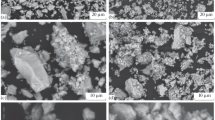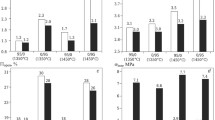Conclusions
We proposed, using zircon as an example, the principle of forming pores of two types — cellular and capillary — for obtaining highly porous (up to 90%) ceramics. It consists of a combination of the foam method and the introduction of removeable foamed polystyrene. At the stage of forming and drying the system is distinguished by a high volume constancy, uniformity of properties, and the possibility of carrying out rapid drying.
On the basis of a zircon suspension as the bond and crushed zircon foamed ceramics as the filler we obtained a highly porous ceramic concrete with a porosity of 50–70% and a compressive strength of 12–24 MPa.
A marked influence on the properties of the resulting materials is exerted by the microcracks formed as a result of the removal of the expanded polystyrene (PPS) in the foamed ceramic, and the presence of uncompensated shrinkage in the ceramic concrete. With an increase in the value of the uncompensated shrinkage from 0 to 7%, the thermal-shock resistance of the ceramic concretes is increased 1.3 times and the thermal conductivity is reduced by a factor of 1.25.
Similar content being viewed by others
Literature cited
A. N. Gaodu and I. S. Kainarskii, Ogneupory, No. 8, 380–383 (1964).
Z. A. Nosova, N. N. Denisova, and T. M. Lyubina, Steklo Keram., No. 7, 34–38 (1969).
Yu. E. Pivinskii and R. G. Makarenkova, Ogneupory, No. 2, 53–57 (1980).
I. Ya. Guzman, Highly Refractory Porous Ceramics [in Russian], Metallurgiya, Moscow (1971).
D. S. Rutman, Yu. S. Toropov, S. Yu. Pliner, et al., Ogneupory, No. 7, 15–16 (1983).
Yu. E. Pivinskii, A. A. Dabizha, and D. S. Rutman, Ogneupory, No. 2, 20–25 (1984).
Inventor's Certificate No. 885225, A. A. Dabizha, Yu. E. Pivinskii, et al., Byull. Izobret., No. 44, 98 (1981).
Yu. E. Pivinskii and A. G. Romashin, Quartz Ceramics [in Russian], Metallurgiya, Moscow (1974).
Yu. E. Pivinskii and P. L. Mityakin, Ogneupory, No. 12, 28–33 (1981).
S. P. Zamyatin, A. K. Purgin, L. B. Khoroshavin, et al., Refractory Concretes [in Russian], Metallurgiya, Moscow (1982).
V. N. Vyrovoi and V. V. Abakumov, in: Summaries of Reports of the Conference “Physicochemical Mechanics of Dispersed Systems and Materials” [in Russian], Part 1, Naukova Dumka (1983), pp. 113–114.
Additional information
Translated from Ogneupory, No. 7, pp. 20–25, July, 1984.
Rights and permissions
About this article
Cite this article
Dabizha, A.A., Pivinskii, Y.E. Production and properties of highly porous zircon materials. Refractories 25, 404–410 (1984). https://doi.org/10.1007/BF01398088
Issue Date:
DOI: https://doi.org/10.1007/BF01398088




